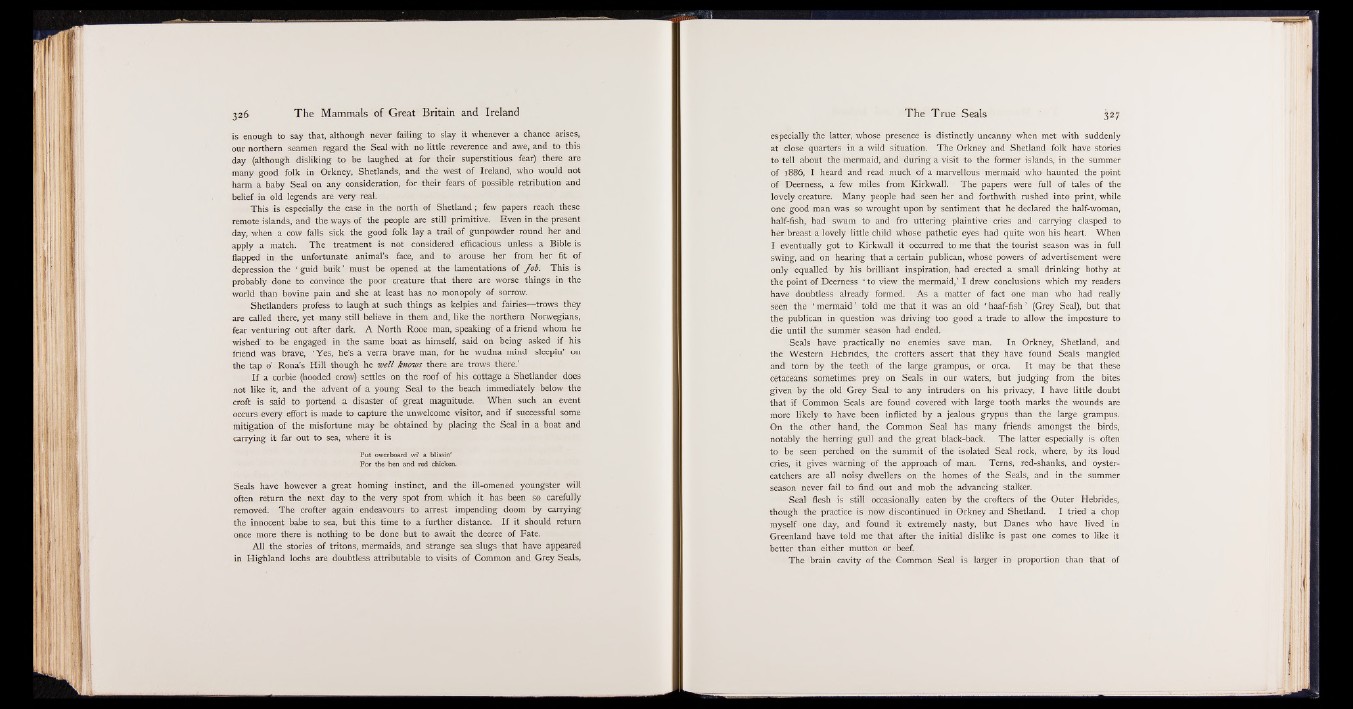
326
is enough to say that, although never failing to slay it whenever a chance arises,
our northern seamen regard the Seal with no little reverence and awe, and to this
day (although disliking to be laughed at for their superstitious fear) there are
many good folk in Orkney, Shetlands, and the west of Ireland, who would not
harm a baby Seal on any consideration, for their fears of possible retribution and
belief in old legends are very real.
This is especially the case in the north of Shetland; few papers reach these
remote islands, and the ways of the people are still primitive. Even in the present
day, when a cow falls sick the good folk lay a trail of gunpowder round her and
apply a match. The treatment is not considered efficacious unless a Bible is
flapped in the unfortunate animal’s face, and to arouse her from her fit of
depression the ‘ guid buik’ must be opened at the lamentations of Job. This is
probably done to convince the poor creature that there are worse things in the
world than bovine pain and she at least has no monopoly of sorrow.
Shetlanders profess to laugh at such things as kelpies and fairies— trows they
are called there, yet many still believe in them and, like the northern Norwegians,
fear venturing out after dark. A North Rooe man, speaking of a friend whom he
wished to be engaged in the same boat as himself, said on being asked if his
friend was brave, ‘ Yes, he’s a verra brave man, for he wudna mind sleepin’ on
the tap 0’ Rona’s Hill though he well knows there are trows there.’
If a corbie (hooded crow) settles on the roof of his cottage a Shetlander does
not like it, and the advent of a young Seal to the beach immediately below the
croft is said to portend a disaster of great magnitude. When such an event
occurs every effort is made to capture the unwelcome visitor, and if successful some
mitigation of the misfortune may be obtained by placing the Seal in a boat and
carrying it far out to sea, where it is
Put owerboard wi’ a blissin’
For the hen and red chicken.
Seals have however a great homing instinct, and the ill-omened youngster will
often return the next day to the very spot from which it has been so carefully
removed. The crofter again endeavours to arrest impending doom by carrying
the innocent babe to sea, but this time to a further distance. If it should return
once more there is nothing to be done but to await the decree of Fate.
All the stories of tritons, mermaids, and strange sea slugs that have appeared
in Highland lochs are doubtless attributable to visits of Common and Grey Seals,
especially the latter, whose presence is distinctly uncanny when met with suddenly
at close quarters in a wild situation. The Orkney and Shetland folk have stories
to tell about the mermaid, and during a visit to the former islands* in the summer
of 1886, I heard and read much of a marvellous mermaid who haunted the point
of Deerness, a few miles from Kirkwall. The papers were full of tales of the
lovely creature. Many people had seen her and forthwith rushed into print, while
one good man was so wrought upon by sentiment that he declared the half-woman,
half-fish, had swum to and fro uttering plaintive cries and carrying clasped to
her breast a lovely little child whose pathetic eyes had quite won his heart. When
I eventually got to Kirkwall it occurred to me that the tourist season was in full
swing, and on hearing that a certain publican, whose powers of advertisement were
only equalled by his brilliant inspiration, had erected a small drinking bothy at
the point of Deerness ‘ to view the mermaid,’ I drew conclusions which my readers
have doubtless already formed. As a matter of fact one man who had really
seen the ‘ mermaid ’ told me that it was an old ‘ haaf-fish ’ (Grey Seal), but that
the publican in question was driving too good a trade to allow the imposture to
die until the summer season had ended.
Seals have practically no enemies save man. In Orkney, Shetland, and
the Western Hebrides, the crofters assert that they have found Seals mangled
and torn by the teeth of the large grampus, or orca. It may be that these
cetaceans sometimes prey on Seals in our waters, but judging from the bites
given by the old Grey Seal to any intruders on his privacy, I have little doubt
that if Common Seals are found covered with large tooth marks the wounds are
more likely to have been inflicted by a jealous grypus than the large grampus.
On the other hand, the Common Seal has many friends amongst the birds,
notably the herring gull and the great black-back. The latter especially is often
to be seen perched on the summit of the isolated Seal rock, where, by its loud
cries, it gives warning of the approach of man. Terns, red-shanks, and oyster-
catchers are all noisy dwellers on the homes of the Seals, and in the summer
season never fail to find out and mob the advancing stalker.
Seal flesh is still occasionally eaten by the crofters of the Outer Hebrides,
though the practice is now discontinued in Orkney and Shetland. I tried a chop
myself one day, and found it extremely nasty, but Danes who have lived in
Greenland have told me that after the initial dislike is past one comes to like it
better than either mutton or beef.
The brain cavity of the Common Seal is larger in proportion than that of